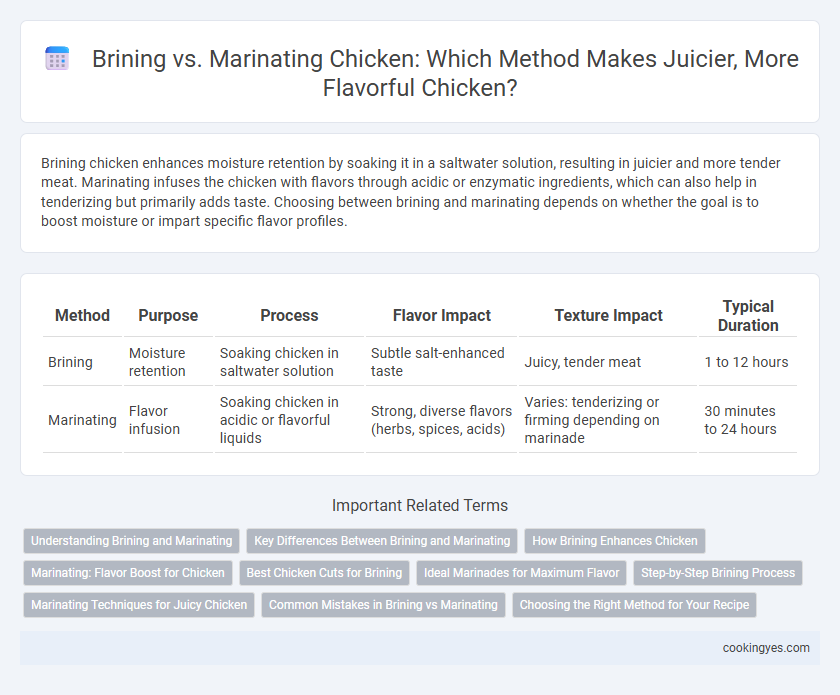Brining chicken enhances moisture retention by soaking it in a saltwater solution, resulting in juicier and more tender meat. Marinating infuses the chicken with flavors through acidic or enzymatic ingredients, which can also help in tenderizing but primarily adds taste. Choosing between brining and marinating depends on whether the goal is to boost moisture or impart specific flavor profiles.
Table of Comparison
| Method | Purpose | Process | Flavor Impact | Texture Impact | Typical Duration |
|---|---|---|---|---|---|
| Brining | Moisture retention | Soaking chicken in saltwater solution | Subtle salt-enhanced taste | Juicy, tender meat | 1 to 12 hours |
| Marinating | Flavor infusion | Soaking chicken in acidic or flavorful liquids | Strong, diverse flavors (herbs, spices, acids) | Varies: tenderizing or firming depending on marinade | 30 minutes to 24 hours |
Understanding Brining and Marinating
Brining involves soaking chicken in a saltwater solution to enhance moisture retention and improve texture, while marinating uses acidic or enzymatic ingredients like vinegar, citrus, or yogurt to infuse flavor and tenderize the meat. Brining primarily affects the chicken's juiciness by altering protein structure, whereas marinating impacts both flavor penetration and surface softening. Understanding these differences helps select the appropriate technique based on desired taste, texture, and cooking method.
Key Differences Between Brining and Marinating
Brining involves soaking chicken in a saltwater solution to enhance moisture retention and tenderness, while marinating uses acidic ingredients like vinegar or citrus to impart flavor and tenderize the meat. Brining primarily affects the chicken's texture by increasing its juiciness, whereas marinating influences surface flavor and can slightly alter texture depending on marinade duration. Understanding these differences helps optimize cooking methods for desired taste and juiciness in chicken dishes.
How Brining Enhances Chicken
Brining enhances chicken by infusing it with moisture and salt, which helps the meat retain juiciness during cooking and prevents it from drying out. The salt disrupts muscle proteins, allowing the chicken to absorb and hold onto water more effectively, resulting in a tender texture and improved flavor penetration. This process also promotes even seasoning, making the chicken consistently flavorful from the surface to the interior.
Marinating: Flavor Boost for Chicken
Marinating chicken infuses the meat with a complex blend of flavors, using acidic ingredients like lemon juice, vinegar, or yogurt paired with herbs and spices to tenderize while enhancing taste. This process allows the marinade to penetrate the chicken, resulting in juicier and more flavorful bites. Selecting the right marinade ingredients and timing can significantly elevate the overall eating experience by balancing acidity, sweetness, and aromatics.
Best Chicken Cuts for Brining
Chicken thighs and drumsticks are the best cuts for brining due to their higher fat content and ability to retain moisture, resulting in juicy, flavorful meat. Brining enhances the texture of these dark meat cuts by allowing the salt solution to penetrate deeply, improving tenderness and seasoning. In contrast, leaner cuts like chicken breasts benefit less from brining and are often better suited for quick marinades that add surface flavor without altering moisture content significantly.
Ideal Marinades for Maximum Flavor
Ideal marinades for chicken combine acidic ingredients like lemon juice or vinegar with flavorful herbs, garlic, and spices to tenderize and infuse the meat with depth. Brining enhances moisture retention through a saltwater solution, but marinades penetrate deeper flavors by breaking down proteins with enzymes and acids. Using ingredients such as yogurt, buttermilk, or citrus-based liquids optimizes tenderness and maximizes flavor complexity for juicy, aromatic chicken dishes.
Step-by-Step Brining Process
The step-by-step brining process for chicken involves submerging the poultry in a saltwater solution, typically containing 1/4 cup of salt per quart of water, for at least 1 to 4 hours to enhance moisture retention and tenderness. After soaking, the chicken should be thoroughly rinsed and patted dry before cooking to remove excess salt and ensure optimal flavor balance. This method improves juiciness and texture compared to marinating, which primarily infuses surface flavors without significantly altering internal moisture.
Marinating Techniques for Juicy Chicken
Marinating chicken infuses flavors deeply while tenderizing the meat through acidic or enzymatic ingredients like lemon juice, yogurt, or pineapple. Optimal marinating times range from 30 minutes to 24 hours depending on the marinade's strength to ensure juiciness without breaking down the flesh excessively. Incorporating oil, herbs, spices, and acids in a balanced marinade enhances moisture retention and intensifies taste in grilled, baked, or roasted chicken recipes.
Common Mistakes in Brining vs Marinating
Common mistakes in brining chicken include using too high salt concentrations or brining for excessive time, which can result in overly salty or mushy meat. In marinating, frequent errors involve using acidic marinades for too long, causing the chicken texture to become tough or mealy. Both processes require precise timing and ingredient balance to enhance flavor and moisture without compromising the chicken's natural texture.
Choosing the Right Method for Your Recipe
Brining chicken enhances moisture retention and juiciness by allowing salt to penetrate the meat, making it ideal for lean cuts like breasts that tend to dry out during cooking. Marinating introduces flavor through acidic or enzymatic ingredients, which also tenderizes the chicken surface but does not penetrate as deeply as brining. Selecting the right method depends on the desired outcome: use brining for juicy, tender chicken with subtle seasoning and marinating for bold, surface-level flavors and slight tenderization.
Brining vs Marinating for Chicken Infographic

 cookingyes.com
cookingyes.com